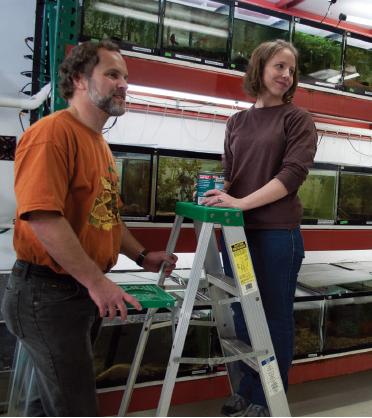Sac State students get statewide attention for fish research

Biological sciences professor Ron Coleman and student Shannon Waters care for many species of fish in Humboldt Hall room 119.
February 8, 2012
The life of tilapia in California’s
Salton Sea became the subject of a project, winning Sacramento
State student Shannon Waters recognition by the CSU Board of
Trustees.
Waters, a graduate student of
biological conservation, was part of a select group of Sac State
students to show light on their research to CSU officials,
including Chancellor Charles Reed, during a board meeting held on
Jan. 24.
“Life or Death on the Salton Sea,” was
one of the projects presented to the board. Ron Coleman, associate
professor of biological sciences, accompanied Waters on her
presentation.
The foundation of Waters’ research is
based upon the reproductive success of tilapia in California’s
Salton Sea – a shallow, salty body of water located in the Imperial
Valley of Southern California and approximately 580 miles from
Sacramento.
The Salton Sea serves as a feeding
ground for pelicans, which rely on the steady reproduction of fish
to sustain its diet.
“The bottom of the sea is very salty,”
Coleman said. “The water is dissolving this salt, which is causing
(freshwater) fish to die, as well as some marine fish.”
Freshwater fish are found in lakes and
rivers, and can survive only in low salinity conditions. In
contrast, marine fish dwell in saltwater locations such as
oceans.
Coleman said there is one species of
fish that does well in the Salton Sea, despite its living
conditions.
“When the tilapias bred, they produced
a very unique hybrid tilapia, which actually does very well in the
Salton,” Coleman said.
Coleman said one reason these tilapia
are able to survive such saline waters is due to an advantageous
trait.
“Cichlids, (a species to which these
tilapia belong) carry their eggs in their mouths,” Coleman said.
“This protection enables this species to produce large numbers very
quickly.”
The salinity of the Salton Sea is an
issue that grows with prominence for Waters and Coleman.
“Every day it gets saltier, because
the water continues to dissolve the salt on the bottom,” Coleman
said. “In 10 years, it is expected to be at 60 parts per
thousand.”
He said on average, an ocean has
approximately 32 grams of solutes per kilogram, which means for
every 1,000 grams of water, there are 32 grams of salt. The Salton
Sea is currently reaching levels of 43 grams of solutes and is
steadily rising.
Coleman said even though the hybrid
tilapia are able to survive these conditions, their reproductive
success is uncertain as the Salton Sea rapidly gets saltier.
One solution is to add fresh water,
but the professor said the shortage of water will affect its
accessibility in terms of price and politics.
“Since we don’t have much freshwater,
it makes it very expensive,” Coleman said. “It is also an issue
that is very politically charged.”
The question driving Waters’ research
was this: How little freshwater can be used to sustain thriving
conditions? Coleman said the project idea originated with Waters,
who has had a long-term interest in this area.
“(The Salton Sea) is a really unique
place,” Waters said. “Some may view it as a stink-hole, but you
have to look beyond the poor air quality and see it for what it
really is.”
Waters said receiving recognition from
the CSU Board of Trustees makes her feel like she is progressing in
the right direction.
“It feels good to bring these lesser
known issues to light,” Waters said.
Coleman said he feels it is important
to spread awareness that student research is still alive and
thriving, and students are exercising their full potential within
the CSU system.
“It shows (the board) that (research)
does matter, and that some students do make a difference,” Coleman
said.
Other projects displayed to the board
include one authored by Katy Janes and co-authored by Jay
Heffernan, both graduate students in geology. Their project showed
how restoration work performed on the American River has affected
salmon’s habitat.
Associate geology professor Tim Horner
accompanied them on their project.
The other project was authored by Sac
State student Emilie Zelazo, who was accompanied by Michelle
Stevens, professor of environmental studies.
Janes said she loves what she does,
and is glad to be able to share her findings with others.
“To be recognized for our efforts is
new to me,” Janes said. “I feel it is always important to give
scientists the chance to show their excitement for what they
study.”
Janes said she understands the
important role of the board, but appreciates the ability to
communicate what goes on at campus level.
“What (the board) does is important,”
Janes said. “It gives all of us at campus level an avenue to do
what we do best, (which is) learn.
“When you are stuck in back to- back
business meetings, and things become about compromise and
negotiation, it’s hard to remember what it’s all for.”
Alex Slavas can be reached at































































































































